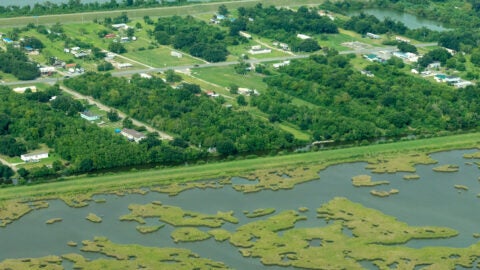Year in Review: 18 numbers that tell 2018’s story of the environment, health, and climate
 2018 brought with it a torrent of stories that now shape the world we live in and will shape 2019 and years to come.
2018 brought with it a torrent of stories that now shape the world we live in and will shape 2019 and years to come.
From a disgraced EPA Administrator, to urgent reports on climate change, the year showed how far we’ve come and how much work remains—especially as President Trump and his administration continue to assault safeguards and deny the reality of a warming world.
Here, we recap the 18 numbers that encapsulate the year that was, and what we’ll be keeping a close eye on in the year to come.
- Public Health Threat #1: Acting EPA Administrator Andrew Wheeler. Former coal lobbyist Wheeler took the reins after the end of Scott Pruitt’s destructive tenure, and picked up right where Pruitt left off. Since then, Wheeler has targeted several foundational health and environmental safeguards. It’s now expected that Wheeler will be nominated for the post permanently. Keep reading to see how dangerous that could be to the American people and our planet.
- Two mothers who lost their sons because of exposure to methylene chloride, a dangerous chemical in common paint strippers, met with Pruitt and members of Congress from both parties. These moms asked EPA to support a ban on consumer and most commercial uses of methylene chloride. Over 6 months ago, Pruitt said he’d do so, but no action has been taken since.
- As for other chemicals the Trump EPA is flouting 2016’s Toxic Substance Control Act amendments, allowing potentially dangerous chemicals into the marketplace and consumers’ homes. Here are three examples.
- Wheeler is proposing to gut the EPA methane rules, a move that could result in more than 400,000 tons of additional potent methane, even though some leading companies have asked EPA to regulate methane emissions from oil and gas.
- Check out this list of five states that took bold action on climate change this year, showing the kinds of common-sense, economic solutions that can be implemented at scale while protecting people, our economy and our environment.
- According to the World Health Organization air pollution kills an estimated 600,000 children every year under the age of 15 and accounts for almost 1 in 10 deaths in children under five. The report found links between air pollution and childhood cancers, asthma, pneumonia and other respiratory infections, making it one of the leading threats to child health.
- It’s not all doom and gloom. Prompted by the urgency to act on climate and the advancement of affordable, renewable energy technologies, we’ve seen seven signs that the global energy economy is in transition.
- Eight hurricanes formed in Atlantic waters this year, two of which—Hurricanes Florence and Michael—devastated states across the Mid-Atlantic and Southeast. These kinds of super storms are becoming more powerful—and more destructive—due to warmer water, higher seas, shifting weather patterns and increased moisture in the air.
- On the other side of the country, California saw wildfires ravage the state, destroying entire towns and killing scores. In total, the fires are expected to cost insurers more than $9 billion and signal the kind of climate dangers the world could face more regularly if greenhouse gases are allowed to pollute our air unchecked.
- Might that have something to do with the fact that fossil fuel industries outspent clean energy advocates on climate lobbying by a startling 10 to 1?
- By EPA’s own calculations, the Mercury and Air Toxic Standards prevent as many as 11,000 deaths per year, yet the Administration reportedly wants to undercut the rule anyway, with a proposal expected imminently.
- A concentrated effort by the oil industry to fight back against clean car standards resulted in more than a quarter of the 12,000 “public” comments submitted to the federal register reflecting the language written by a pro-industry group. Marathon Petroleum, the country’s largest refiner, lobbyists for Exxon Mobil, Chevron, and Phillips 66, joined a network funded by the Koch Brothers network in a massive effort to fight standards that would reduce pollution from vehicles and save Americans money at the gas pump.
- The National Climate Assessment, issued by 13 federal agencies, sounded the alarm on the impacts America stands to suffer from climate change, yet went largely ignored by the Trump Administration, which has chosen to side with special interests and industry allies.
- 414 investors across the globe—with $31 trillion under management—called for governments to take serious steps to curb climate pollution, citing the “ambition gap” between government commitments and what is needed to sufficiently prevent the world from reaching warming of 2 degrees Celsius above pre-industrial levels.
- 2015 saw the adoption of the landmark Paris Agreement, setting nations on a hopeful path toward emissions reduction. Since then, the leadership once shown by America in critical climate talks has been abdicated, left vacant by an administration that chooses to cover its ears and place the world’s children and grandchildren at risk. This year’s climate summit, COP24, saw the creation of a “rule book” to implement the Paris agreement, but also showed that much more needs to be done.
- A letter sent by coal baron Robert E. Murray to Vice President Mike Pence listed 16 wishes that the administration has largely taken up as policy. Several among them have led the administration to foolishly attempt to prop up the coal industry despite economic signals diminishing coal’s viability, not to mention its severe health and environmental effects.
- After 17 months of countless scandals and reckless attempts to assault bedrock environmental protections, Scott Pruitt resigned his post as EPA Administrator. This list could extend dozens of items longer if we were to count Pruitt’s many offenses. American families and children will not miss him.
- A cheery and hopeful note as we head toward the new year: 2018’s midterms saw a wave of pro-environment and climate candidates elected to office across the country. Those candidates-elect—ranging from governors and representatives, to mayors and councilwomen—are leading a charge toward ambitious climate action.
What we’ll be keeping our eye on in 2019:
- Wheeler hearing: President Trump is expected to formally nominate Andrew Wheeler as Administrator of EPA. This will likely set up a Senate confirmation hearing for January or February. Will the Senate endorse Wheeler’s attacks on environmental safeguards?
- Mercury and Air Toxics Standards: Wheeler may soon begin undoing federal mercury and air toxics standards , which limit dangerous mercury and other poisonous and cancer-causing substances from the nation’s coal plants. Will EPA move ahead with this dangerous move, even given industry and bipartisan support for the protections?
- Climate Action in Congress: There’s no question climate discussions in Washington are heating up. Will the new majority in the House of Representatives develop climate legislation? How will climate be addressed in any infrastructure bill? What movement will we see to advance clean energy?
- Congressional Oversight & Accountability: Will the new Congress return to its vigorous oversight function to hold Wheeler accountable for implementing President Trump’s attacks on environmental safeguards? What issues will Wheeler face?
- Climate Action in the States: Across the country, states have been stepping up to deal with climate change. Will there be surprises? Who which governors take the lead on climate action?
- Climate Change and Military Preparedness: The Defense Department is overdue in releasing a climate vulnerability report, identifying the armed services installations that are most vulnerable to climate change. Which bases will be found to be most at risk in a changing climate?
- Methane: Days before the holidays, Wheeler was also faced with an outpouring of opposition by health experts, moms, attorneys general and more to his proposal to weaken the EPA methane rules. Even ExxonMobil came out in support of regulating methane. Will Wheeler finalize this unpopular weakening of a common sense rule? Will he move forward with an even more severe attempt to gut regulations of this dangerous climate pollutant?
- Clean Car Standards: The Trump administration has proposed to roll back clean car standards—a step that would massively increase climate pollution and cost Americans hard-earned money at the gas pump. Will the administration finalize this rollback in 2019? Or will they listen to sound science and keep the strong standards in place, especially following a New York Times investigation uncovering the oil industry’s role in pushing the rollback?
- Censored Science: Wheeler may revive a widely discredited attempt to limit how much science EPA can use when assessing environmental safeguards that are key to protecting human health. The effects of his action could include looser restrictions on air pollution and deadly chemicals in our drinking water, paint and paint strippers and wood products.
- Chemical Safety: Industry lobbyists and conflicted political appointees controlling the EPA spent much of 2018 diligently working to undermine our strengthened chemical safety system. With the new year, there will certainly be new toxic chemicals allowed onto the market without adequate review and new attacks on the reformed Toxic Substances Control Act.
- Lead Exposure: Days before the holiday, the Trump Administration released a deeply disappointing federal “Lead Action Plan.” As the administration touts its efforts on tackling lead exposure, will Wheeler follow through with his promise to release the long delayed revision of the Lead & Copper Rule in spring and new lead dust standards in June — and will they actually offer better protections?
- Climate Action on the Campaign Trail: Last but certainly not least, the 2020 campaign is heating up. As polling shows that climate change is becoming a priority for more voters, will presidential candidates make dealing with climate change central to their platforms?












